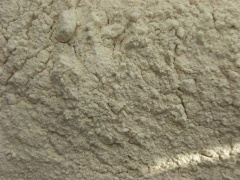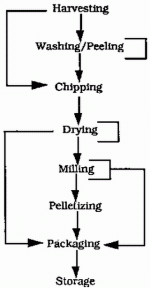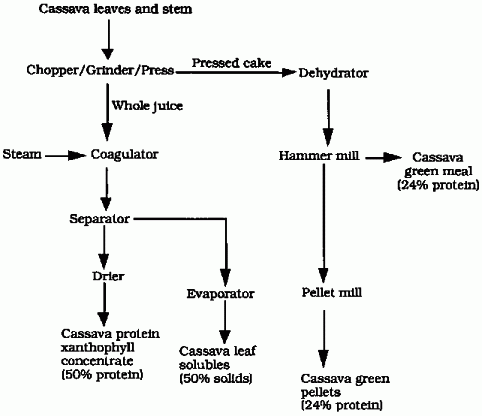Cassava Meal
| Infobox on Cassava Meal | |
|---|---|
| Example of Cassava Meal |  |
| Facts | |
| Origin | Asia |
| Stowage factor (in m3/t) | 1,7/1,8 m3/t (bulk/pellets) |
| Humidity / moisture | 12-14% |
| Ventilation | See text |
| Risk factors | See text |
Cassava Meal
Contents
Description
The Cassava Root is long and tapered, with a firm, homogeneous flesh encased in a detachable rind, about 1mm thick, rough and brown on the outside. Commercial varieties can be 5 to 10 cm in diameter at the top, and around 15 cm to 30 cm long. A woody cordon runs along the root's axis. The flesh can be chalk-white or yellowish. Cassava roots are very rich in starch, and contain significant amounts of calcium (50 mg/100g), phosphorus (40 mg/100g) and vitamin C (25 mg/100g). However, they are poor in protein and other nutrients. In contrast, cassava leaves are a good source of protein (rich in lysine), but deficient in the amino acid methionine and possibly tryptophan.
The most common types of feedstuffs produced from cassava roots are chips and pellets. Chips are the dried shredded root and are of variable size, shape, and quality depending on rate of drying and contamination with sand during the processing. The chips can be directly ground and used in mixed feeds or pelleted. The root pellet is a uniform cylindrical product of about 0.5 to 0.8 cm diameter and 1.0 to 2.0 cm long. Pelleting produces a more compact product and reduces dust, thus facilitating storage and transportation.
Pellets have a lower nutritional value than chips because they include part of the shoot, which increases fiber and ash content from 1.5 to 2.0%. Cassava root meal is mainly a source of energy, with a high starch content (about 60-70%). However, the level of protein is very low, being approximately 2.5% of dry matter. Thus, the inclusion of cassava in diets depends on cost and availability of other energy and protein sources. When a balanced poultry ration is formulated, the cassava must be supplemented with protein, amino acids, fat, minerals, and vitamins at higher levels than are needed in cereal-based diets. Cassava root products are deficient in carotene and other coloring carotenoids. Consequently these elements must be added to cassava based
diets if the market requires a high degree of pigmentation of Egg Yolk or broiler skin. Because cassava pellets are high in potassium, limiting their inclusion to reduce the moisture content of feces may be appropriate.
The cassava plant, made up of the roots, leaves and stem, is a good source of carbohydrate and protein. The different parts of the plant can be used as animal feed. The leaves can be used as silage, dried for feed supplementation and as leaf meal for feed concentrates. The stem can be mixed with leaves and used as ruminant feed, or dried for feed concentrates. The roots can be chipped or pelletized and used as feed, while the root peel, broken roots, fiber and baggase from starch extraction and gari processing can be dried and used directly as animal feed or as substrate for single cell protein production. The use of cassava root as animal feed is increasing in importance in the developing countries of Latin America and Asia where an export market for this commodity has developed. The European Economic Community imports about 6 million tonnes of cassava annually in the form of pellets or granules. Thailand and Indonesia are the world's largest exporters of dried cassava products, largely in the form of pellets. In Thailand, cassava is almost entirely utilized as cassava pellets and starch for export.
Processing of cassava into chips and pellets
The flow chart for this process is shown in figure 1.
The production of chips is an intermediate stage in the production of pellets. There is very little difference in the technologies used at different scales of chip and pellet production. The main difference is in sun-drying and mechanical drying. Chips can be produced by very simple techniques in the household or village as well as on a large mechanized scale.

Figure 1: Flow chart for the production of cassava chips and pellets
After drying, the cassava chips are packed in either jute or polyethylene bags, or processed further into pellets. The commercial purpose of pelletizing Cassava Root products is to decrease the volume by 25-40 percent to produce a uniform product, to facilitate bulk handling during transportation, loading and reloading and to eliminate the dustiness of the product. Pelletizing contributes significantly to the density, durability, and quality of the product. If the chips are big, the cassava chips are first harmmer-milled and then preconditioned. During the preconditioning the moisture content is increased to between 16 and 18 %. This is usually achieved either by spraying water or by adding steam.
Pelletization is done in continuous die presses.The chips are forced through small holes in the die causing a rise in temperature through friction. This gives the pellets cohesion, but also causes considerable wear on the die and makes pelletizing energy intensive. The best results are obtained with rather small chips with 13-14 % moisture content which are heated to 65°C and moistened to 15-17% just before pressing. After pressing, the pellets are cooled, during which the moisture content drops to 14%, and packed in jute or polyethylene bags.
Factors affecting the quality of pellets are the composition of the material, protein, starch, fiber, and fat content. Protein-rich materials plasticize when heated and act as a binder to produce strong pellets. Starches gelatinize when heated in the presence of water and also act as binder to produce strong pellets. Fibers are difficult to compress but when they are present in sufficiently fine strands in the pellet, they give toughness to the product. Fats act as lubricants, resulting in easy pressing and therefore high capacity and lower power consumption.
Processing of cassava leaves and stems
Dried cassava leaves and stems have been fed to pigs, poultry, and dairy cattle. The meal produced from them has a nutritive value similar to that of alfalfa though deficient in methionine, isoleucine and threonine. Cassava leaves are a good source of about 20% protein. The amount of protein depends on the stage of growth. The processing of the aerial part of the cassava plant made up of both the leaves and the stem is shown in figure 2. For the extraction of cassava leaf protein, the leaves and the stem are interacted in a chopper or grinder and the juice pressed out. The extracted juice is then coagulated with injection of steam. The pressed cake is sent to the dehydrator. The coagulated juice is then sent to a separator where the soluble fraction is separated from the green curd and moved to the evaporator where it is concentrated to 50% by volume. The curd is sent to the drier to produce the cassava protein concentrate which is 50% protein.

Figure 2: Flow chart for processing cassava leaves and stems
Pellets and cassava meal can be produced from either the pressed cake or whole leaves and stem by first passing them through a dehydrator to reduce the moisture content to about 15-20 %. The dried cake is then passed through a hammer mill to produce the cassava green meal which contains about 24% protein. The dried meal can be further processed into pellets by passing through a pellet mill to produce cassava green pellets. Antioxidant is sometimes added at the milling stage.
Shipment / Storage / Risk Factors
The product is shipped in bags and also in bulk in pellet form.
Liable to infestation. Subject to loss in weight by drying out. When meal is in pellet form it is liable to spontaneous combustion. Should be stowed away from moist and odorous goods. Good ventilation is essential.
Reference is made to the relevant IMO publications of hazardous cargo.











